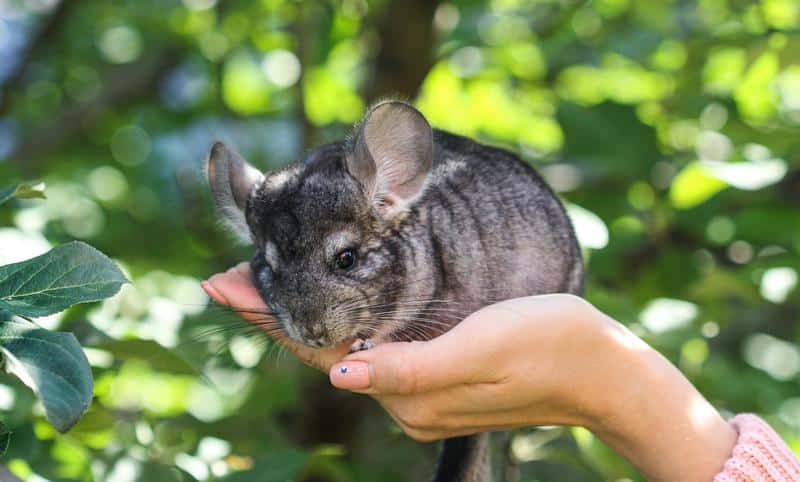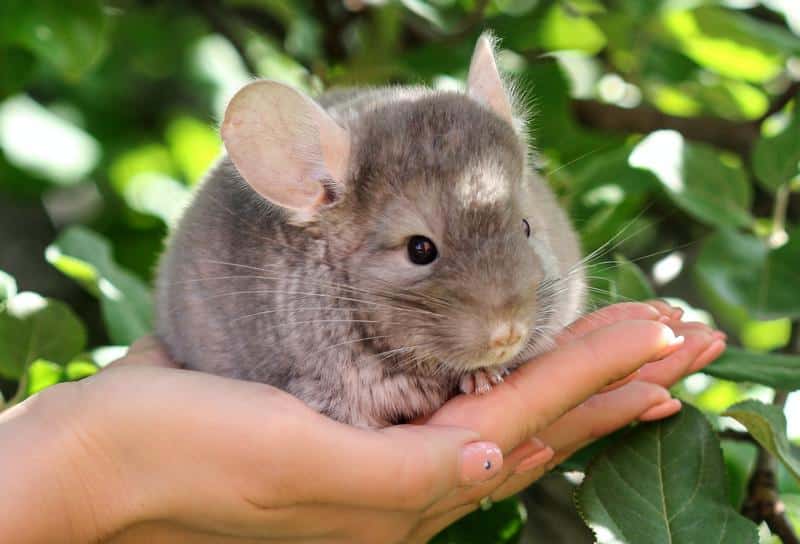Chinchillas with Dogs: Do They Get Along? (+How to Help!)
Chinchillas with dogs: do they get along? In this article, we’ll talk about if chinchillas and dogs can live together peacefully, while also giving you a quick and easy-to-follow guide on introducing chinchillas and dogs so you can be sure their first meeting goes great.
Next, we’ll cover two very important health-related questions: “Is chinchilla poop toxic to dogs?” and “Can chinchillas give dogs diseases?” Finally, if your dog won’t stop barking at your chinchilla, we’ve got tips on how to manage this too. Keep reading to learn all this and more!
Chinchillas with Dogs: Can They Get Along?

Having chinchillas with dogs in the same household living together peacefully depends on the individual animals’ temperaments, their environment, and the owner’s diligence. With proper introduction, supervision, and training, they can potentially coexist without issue. However, precautions are necessary due to the natural predator-prey relationship.
Are Chinchillas Good With Dogs?
Chinchillas are small, quiet, and skittish creatures by nature. They are likely to be scared by dogs, which are larger, louder, and more active. The chinchilla’s natural instinct is to run away and hide from threats, which could potentially be triggered by a dog’s presence.
Chinchillas are also fragile, and even a playful dog could unintentionally hurt them. Hence, compatibility is more about whether the dog can behave appropriately around the chinchilla rather than the other way around.
Introducing Chinchillas and Dogs
A crucial step in creating harmony between chinchillas and dogs is the introduction process. Initial introductions should always be done in a controlled environment, with the chinchilla in its cage and the dog on a leash. Rewarding your dog for calm behavior during these sessions can help reinforce the message that they must be gentle around the chinchilla.
Training Your Dogs with Chinchillas
Dogs must be trained to behave around chinchillas. Commands like “leave it” or “stay” can be particularly useful. Dogs with high prey drives may require more intensive training and supervision to ensure the safety of the chinchilla.
Creating Safe Spaces
Chinchillas should always have a safe space where they can escape to. This could be their cage, elevated platforms, or separate rooms where the dog is not allowed to enter. This is a necessity to ensure the chinchilla’s safety and comfort.
Do Chinchillas Get Along With Dogs?
Chinchillas do get along with dogs in most cases, but you must always remember that dogs are naturally predatory while chinchillas are prey animals. This dynamic could potentially stress the chinchilla, so watch closely for signs they’d like to go back to their cage.
And while these steps will get your dog to get along with your chinchillas, you need to know that the underlying behavioral issues (prey drive, anxiety, overexcitement, etc.) that were causing all of this to begin with will still be present. And until you address those, any positive changes you see are only going to be temporary.
“Well, how do I make these changes last?”
By getting your dog to truly choose to follow your direction, that’s how. I tried many times to write out how you can do this before deciding it made more sense to just link you to the free video series that explains it better than I’d ever be able to.
The series is by a man named Dan who is one of the world’s leading dog obedience trainers. In it, he teaches you how to put an end to things like when your dog isn’t getting along with your chinchillas and all other misbehavior using his fast and easy-to-follow methods.
In the first video, Dan will reveal to you why the two most common methods of dog training only doom you to failure. You can watch the video now by clicking here. Follow the proven system he’ll show you in his series and you’ll never have to spend another second worrying about your dog not getting along with your chinchillas ever again!
Chinchillas and Dogs: How to Introduce

Introducing chinchillas and dogs requires careful planning and patience, focusing on their safety and stress levels. The introduction process should be gradual, closely supervised, and consider the temperament, breed, and behavior of your dog.
- Assess Your Dog’s Temperament: Before introducing chinchillas and dogs, it’s vital to evaluate your dog’s temperament. If your dog has a high prey drive or shows aggressive behavior toward smaller animals, it might be risky to introduce a chinchilla. Learn how to treat this underlying behavioral issue in the first section.
- Keep Them Separated Initially: Start by keeping the animals in separate rooms. This allows both pets to become accustomed to the presence of another animal in the house without direct interaction. Use baby gates or closed doors to enforce this separation.
- Gradual Scent Introductions: Introduce each pet’s scent to the other. This could be done by swapping bedding or using a soft cloth to rub each animal and placing it in the other’s area. This gradual introduction can help reduce anxiety and aggression when they meet face-to-face.
- Controlled Meetings: When both animals seem comfortable with the scent introduction, you can progress to controlled meetings. This should be done in a neutral area where neither pet feels territorial. Your dog should be on a leash, and your chinchilla should be in a safe, secure carrier to prevent any physical contact. Observe their reactions and behaviors closely.
- Monitor Their Interactions: If the controlled meetings go well, you can allow them to interact more freely, but always under close supervision. Remember, due to the size difference and the dog’s potential prey drive, leaving them alone together is not recommended.
- Take Your Time: Remember, these introductions can take days, weeks, or even months. Patience is key. You should never rush the process and force interactions, as it may stress the animals and cause a negative reaction.
Remember, every dog and chinchilla is unique. Some may cohabitate well, while others may not. It’s crucial to prioritize the safety and well-being of both your pets throughout the introduction process. For more help you’ll likely need on this issue, go back to the first section now.
It’s important not to delay and to get this problem taken care of now, particularly if you plan on having (or already do have) lots of other animals in the home. This will ensure that you have great interactions between your hamsters and dogs, ferrets and dogs, and dog and guinea pigs.
Is Chinchilla Poop Toxic to Dogs?
Chinchilla poop is not toxic to dogs. However, if a dog ingests it, there could be potential health risks due to bacteria, parasites, or foreign bodies. It’s always best to prevent your dog from eating chinchilla poop or any other non-food items to maintain their health and well-being.
Understanding Coprophagia in Dogs
Coprophagia, or the act of consuming feces, is a behavior exhibited by some dogs. It can be due to a variety of reasons, including nutritional deficiencies, stress, boredom, or curiosity. While it might not be harmful in some cases, it’s a behavior that should be discouraged to prevent potential health issues.
Health Risks of Eating Chinchilla Poop
Although chinchilla feces are not toxic per se, they could still pose a health risk for your dog. Fecal matter can carry parasites and harmful bacteria, or contain undigested parts of the chinchilla’s diet which could potentially cause digestive upset or blockages in dogs.
Preventing Your Dog From Eating Chinchilla Poop
Prevention is key to ensuring your dog does not eat chinchilla poop. Make sure to clean the chinchilla’s cage regularly to remove feces. Also, never leave your dog unsupervised around the chinchilla’s cage. Training your dog to respond to commands like “leave it” can also be helpful in preventing this behavior.
What to Do If Your Dog Eats Chinchilla Poop
If your dog has eaten chinchilla poop, monitor them closely for any signs of illness such as vomiting, diarrhea, loss of appetite, or unusual behavior. If any of these signs appear, it’s important to contact a veterinarian for advice. It’s always better to be safe and ensure your pet is not at risk.
While chinchilla poop is not toxic to dogs, it’s best to prevent your dog from ingesting it to avoid any potential health risks. Proper hygiene and training can help maintain a healthy environment for both your dog and chinchilla. Learn about handling your dog’s behavior around your chinchilla in the first section of this article.
Can Chinchillas Give Dogs Diseases?
Chinchillas can give dogs diseases potentially, but it’s relatively rare. Some zoonotic diseases (those that can transfer from animals to humans) like certain parasites or fungal infections could potentially spread to dogs. However, with proper hygiene and veterinary care, the risk can be significantly reduced.
- Parasites: Like many small pets, chinchillas can sometimes carry parasites such as mites or fleas, which may also infest dogs. Regular parasite treatments for both your chinchilla and dog, as well as keeping their living environments clean, can prevent this.
- Fungal Infections: Chinchillas can get fungal infections like ringworm, which is contagious to both dogs and humans. If your chinchilla has a skin condition, consult a vet and avoid direct contact until it’s been treated.
- Bacterial Infections: Although rare, bacterial infections like salmonella or leptospirosis can theoretically pass from chinchillas to dogs. However, these diseases are more commonly associated with other types of rodents, and transmission is unlikely with proper hygiene and care.
- Risks from Feces: Both chinchilla and dog feces can carry bacteria or parasites. To reduce risk, promptly clean up feces and prevent your dog from investigating or ingesting it.
- Regular Vet Check-ups: Routine veterinary examinations for both your chinchilla and your dog can help detect any health issues early, reducing the chance of disease transmission. Remember to tell your vet about all the pets in your household so they can advise on potential risks.
While it’s crucial to be aware of potential health risks, with regular vet care and good hygiene practices, the risk of diseases spreading from chinchillas to dogs is quite low. Always monitor your pets’ health and behavior closely and consult a vet if you notice any changes or concerns. To make sure your dog gets along with your chinchilla, go back to the first section.
How to Stop Dog Barking at Chinchillas
To stop your dog from barking at chinchillas, use positive reinforcement training methods like rewarding calm behavior, using the ‘quiet’ command, and gradually desensitizing your dog to the chinchilla’s presence. It’s also important to ensure your dog is well-exercised and mentally stimulated to avoid boredom, which can lead to excessive barking.
Understanding Why Dogs Bark at Chinchillas
Dogs bark at chinchillas due to their natural predatory instincts, curiosity, or because they are stressed or anxious. Understanding the reason for your dog’s behavior is the first step in addressing it.
Training Your Dog to Be Quiet
The ‘quiet’ command is a powerful tool in curbing excessive barking. When your dog starts barking at the chinchilla, say ‘quiet’ in a firm, calm voice. Once they stop barking, reward them with a treat or praise. Repeat this until your dog associates the command with stopping the barking.
Desensitization and Counterconditioning
Gradually desensitizing your dog to the presence of the chinchilla can also help. Start by allowing your dog to observe the chinchilla from a distance while rewarding calm behavior. Over time, slowly decrease the distance while continuing positive reinforcement.
Maintaining Regular Exercise and Mental Stimulation
Regular physical exercise and mental stimulation help manage your dog’s energy levels and reduce boredom, potentially reducing their interest in barking at the chinchilla.
Address Underlying Issues
If you’re struggling to manage your dog’s barking, you likely have an underlying behavioral issue that needs to be addressed before you’ll make any lasting progress. Go back to the first section now and we’ll explain how to help your dog with their problem.
With patience, consistent training, and understanding, you can successfully curb your dog’s tendency to bark at chinchillas. Remember, every dog is unique, and it’s important to find a method that works best for your specific situation.
I’m sure you’re ready for your chinchillas and dogs to live together in harmony, so I’ll let you get started on all of this now. Good luck with everything, and thanks for reading our article “Chinchillas with Dogs: Do They Get Along? (+How to Help!)”.





